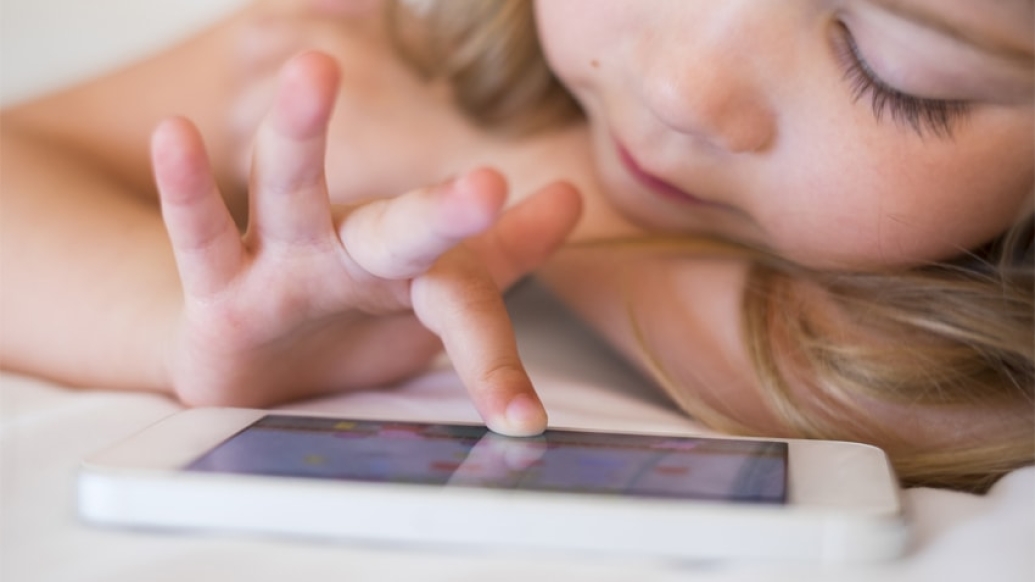A game-stocked smartphone or tablet shouldn’t just be used to keep kids quiet. Hand-held tech tools, a U-M pediatrician maintains, ought to be a family affair.
2:00 PM
Author |

When young kids want screen time with smartphones or tablets, the habit shouldn't be a solitary one.
MORE FROM THE LAB: Sign up for our weekly newsletter
Sure, it's no secret among parents that compact gadgets are go-to pacifiers when a tantrum arises or dinner has yet to be made, but excessive unsupervised use harbors a silent hazard: a lost opportunity for families to interact and, in turn, boost a child's vocabulary.
"As technology becomes smaller and more hand-held, it is much harder to view it together," says Jenny Radesky, M.D., an assistant professor of pediatrics at the University of Michigan — and a mother of two boys, ages 6 and 2.
"There's less shared use of technology with little kids and more 'passing it off.'"
A child and adult watching Sesame Street together on a television, by comparison, allows for explanation of concepts and joint dialogue. That's key, Radesky says, for making screen time worthwhile and not just a distraction.
Still, she knows that kids and digital devices are inevitably linked and that the relationship (or, at times, obsession) isn't going away.
So when her kids ask to use her iPhone, Radesky plays along to make the exchange a collaboration.
"I let my boys look at pictures on the phone; we talk about memories together and we tell stories," says Radesky, who will speak about the issue next week at the Pediatric Academic Societies Meeting in Baltimore.
The tactic of engaging with children around technology, rather than letting kids use it solo, she thinks, could be another way to help narrow the "word gap" — the crux of a 1995 study that found that, because of a lack of engaging conversations in the home, low-income children heard 30 million fewer words before age 3 than their wealthier peers. Several studies have suggested that background TV or other digital distractions may contribute to less parent-child interaction in the home.
I always tell parents to play a new app first so you know what it's trying to teach them. Find something in their zone of development — whether it be colors or puzzles or reading — play it with them and have them tell you what they did.Jenny Radesky, M.D.
Reaching out to parents
When it comes to solving language exposure disparities, cellphones also have the potential to be a valuable tool for parents.
A 2014 study by the National Bureau of Economic Research found that text-message reminders sent to parents of preschoolers — with simple tips on literacy-related topics such as reading aloud and practicing phonetics — ultimately helped those kids score better on literacy tests compared with children of parents that did not receive such text messages.
SEE ALSO: Reducing Birth Defect Rates? There's an App for That
"These have been shown to improve parents' knowledge and practices," says Radesky. She notes that the overall tone of the messages was positive, not pushy. "I love some of the texts that I've seen."
One such directive, she recalls, was for parents to get out an old photo album to share memories of older relatives with their children. That could spawn crucial face-to-face quality time, no phones required.
Another texting-based effort designed to close the word gap is part of the ongoing Too Small to Fail initiative — a charitable program co-sponsored by Clinton Global Initiative America — that pinged tips to parents on the importance of talking, reading and singing with their young children.
One motive for the cellphone based methodology in both cases, Radesky says, is the fact that poor families are less likely to own tablets or computers to access web-based educational resources. Many lack standard landline service, too.
Striking a balance
The notion of phones and kids, however, raises a key question: How much screen time is too much?
According to the American Academy of Pediatrics, children ages 2 and older should have no more than two hours of screen-based entertainment per day.
"You want the rest of the day for the child to get outside, be physically active, do their homework," says Radesky, who is co-authoring the upcoming screen-time guidelines, due out this fall.
Radesky, a fan of apps like the Sesame Workshop collection, maintains that the quality and context of digital media matter as much as the amount of time spent consuming it.
"I always tell parents to play a new app first so you know what it's trying to teach them," she says. "Find something in their zone of development — whether it be colors or puzzles or reading — play it with them and have them tell you what they did."
If a game is boring, repetitive or violent, uninstall it.
While sharing in the moment remains an important part of the developmental process, hand-held devices clearly can offer a respite when needed.
"I'll be honest: I will sometimes give my child a Lego app and say, 'I'm going to get some work done and I'll see you in half an hour' — and that's OK," Radesky says. "But then, later, we'll go play with real hands-on Legos."

Explore a variety of healthcare news & stories by visiting the Health Lab home page for more articles.

Department of Communication at Michigan Medicine
Want top health & research news weekly? Sign up for Health Lab’s newsletters today!





